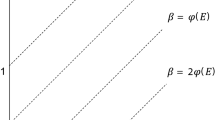Abstract
In normative decision theory, the weight of an uncertain event in a decision is governed solely by the probability of the event. A large body of empirical research suggests that a single notion of probability does not accurately capture peoples' reactions to uncertainty. As early as the 1920s, Knight made the distinction between cases where probabilities are known and where probabilities are unknown. We distinguish another case –- the unknowable uncertainty –- where the missing information is unavailable to all. We propose that missing information influences the attractiveness of a bet contingent upon an uncertain event, especially when the information is available to someone else. We demonstrate that the unknowable uncertainty –- falls in preference somewhere in between the known and the known uncertainty.
Similar content being viewed by others
References
Becker, S.W. and Brownson, F.O. (1964), What price ambiguity? Or the role of ambiguity in decision making. Journal of Political Economy 72: 62–73.
Boiney, L. (1993), The effects of skewed probability on decision making under ambiguity. Organizational Behavior and Human Decision Processes 56: 134–148.
Camerer C and Weber, M. (1992), Recent developments in modeling preferences: Uncertainty and ambiguity. Journal of Risk and Uncertainty 5: 325–370.
Curley, S.P. and Yates, F.J. (1985), The center and range of the probability in-terval as factors affecting ambiguity preferences. Organizational Behavior and Human Decision Processes 36: 272–287.
de Finetti, B. (1937), La prevision: ses lois logiques, ses sources subjectives. Annales de lŠInstitute Henri Poincaré 7: 1–68[Reprinted in English in Kyburg and Smolder (1964)].
Ellsberg, D. (1961), Risk, ambiguity, and the savage axioms. Quarterly Journal of Economics 75: 643–669.
Fox, C.R. and Tversky, A. (1995), Ambiguity aversion and comparative ignor-ance. The Quarterly Journal of Economics 110(3): 585–603.
Frisch, D. and Baron, J. (1988), Ambiguity and rationality. Journal of Behavioral Decision Making 149–157.
Heath, C. and Tversky, A. (1991), Preference and belief: Ambiguity and com-petence in choice under uncertainty. Journal of Risk and Uncertainty 4: 5–28.
Hogarth, R.M. and Kunreuther, H. (1989), Risk, ambiguity, and insurance. Journal of Risk and Uncertainty 2: 5–35.
Kahn, B.E. and Sarin, R.K. (1988), Modeling ambiguity in decisions under uncertainty. Journal of Consumer Research 15: 265–272.
Keppe, H. and Weber, M. (1995), Judged knowledge and ambiguity aversion. Theory and Decision 39: 51–77.
Keynes, J.M. (1921), A Treatise on Probability. London: Macmillan.
Knight, F.H. (1921), Risk, Uncertainty, and Profit. Chicago: University of Chicago Press.
Locke, J. (1990), An essay concerning human understanding. In: Clarendon Edition of the Works of John Locke. Oxford: Clarendon Press.
MacCrimmon, K.R. and Larsson, S. (1979), Utility teory: Axioms versus para-doxes. In: Allais, M. and Hagen O. (eds). Expected Utility Hypotheses and the Allais Paradox, Boston: Reidel.
Raiffa, H. (1984), Back from prospect theory to utility theory. In: Gauer, M., Thompson, M. and Wierzibicki, A.P. (eds). Plural Rationality and Interactive Decision Processes, New York: Springer.
Sarin, R.K. and Weber, M. (1993), Effects of ambiguity in market experiments. Management Science 39: 603–615.
Savage, L.J. (1954), The Foundations of Statistics. New York: Wiley.
Slovic, P. and Tversky, A. (1974), Who accepts Savage's axiom? Behavioral Science Vol. 19: 368–373.
Yates, F.J. and Zukowski, L.G. (1976), Characteristics of ambiguity in decision making. Behavioral Science 21: 19–25.
Rights and permissions
About this article
Cite this article
Chua Chow, C., Sarin, R.K. Known, Unknown, and Unknowable Uncertainties. Theory and Decision 52, 127–138 (2002). https://doi.org/10.1023/A:1015544715608
Issue Date:
DOI: https://doi.org/10.1023/A:1015544715608




